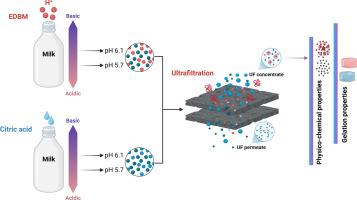Gelation properties of acidified skim milk concentrates produced by bipolar membrane electrodialysis prior to ultrafiltration
IF 8
1区 农林科学
Q1 FOOD SCIENCE & TECHNOLOGY
引用次数: 0
Abstract
Electrodialysis with bipolar membranes (EDBM) provides a method for milk acidification, with potential for improving pH stability and modifying the gelation properties of milk concentrates compared to conventional acidification using citric acid (CA). Simultaneously slowly acidifying and removing cations, EDBM maintains a distinct mineral profile that enhances ultrafiltration (UF) performance, reduces membrane fouling, and improves the properties of milk protein concentrates. EDBM-treated UF concentrates showed different gelation properties after rennet-, acid-, and heat-induced gelation compared to CA acidified concentrates. At pH 5.7, rennet-induced gels from EDBM-treated milk were stronger and more deformable, whereas CA-acidified milk yielded more brittle and heterogeneous gels. At pH 6.1, acid-induced gels from CA acidified concentrates showed an earlier gelling point than EDBM concentrates, while at pH 5.7, the opposite is observed. Similarly, heat-induced gels from EDBM-treated milk display higher shear moduli (G′). EDBM is a promising alternative to traditional acidification, helping to modulate the texture and functionality of milk concentrates.

超滤前双极膜电渗析生产的酸化脱脂奶浓缩物的凝胶特性
双极膜电渗析(EDBM)提供了一种牛奶酸化方法,与使用柠檬酸(CA)的传统酸化相比,具有改善pH稳定性和改变牛奶浓缩物凝胶特性的潜力。在缓慢酸化和去除阳离子的同时,EDBM保持了独特的矿物质特征,增强了超滤(UF)性能,减少了膜污染,并改善了牛奶蛋白浓缩物的性能。edbm处理过的UF浓缩物在凝乳酶、酸和热诱导胶凝后的胶凝性能与CA酸化浓缩物不同。当pH值为5.7时,经edbm处理的牛奶中凝血酶诱导的凝胶更坚固,更易变形,而经ca酸化的牛奶中凝血酶诱导的凝胶更脆,且不均匀。当pH值为6.1时,CA酸化浓缩液的酸诱导凝胶的胶凝点比EDBM浓缩液早,而在pH值为5.7时,则相反。同样,edbm处理过的牛奶的热诱导凝胶显示出更高的剪切模量(G ')。EDBM是一种很有前途的替代传统酸化,有助于调节牛奶浓缩物的质地和功能。
本文章由计算机程序翻译,如有差异,请以英文原文为准。
求助全文
约1分钟内获得全文
求助全文
来源期刊

Food Research International
工程技术-食品科技
CiteScore
12.50
自引率
7.40%
发文量
1183
审稿时长
79 days
期刊介绍:
Food Research International serves as a rapid dissemination platform for significant and impactful research in food science, technology, engineering, and nutrition. The journal focuses on publishing novel, high-quality, and high-impact review papers, original research papers, and letters to the editors across various disciplines in the science and technology of food. Additionally, it follows a policy of publishing special issues on topical and emergent subjects in food research or related areas. Selected, peer-reviewed papers from scientific meetings, workshops, and conferences on the science, technology, and engineering of foods are also featured in special issues.
 求助内容:
求助内容: 应助结果提醒方式:
应助结果提醒方式:


